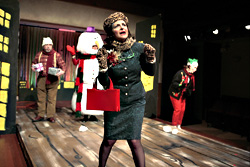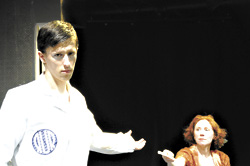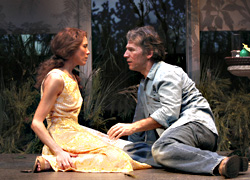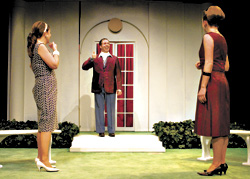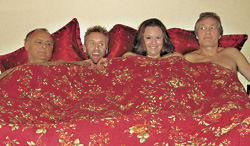The Farndale Avenue Housing Estate Townswomen’s Guild Dramatic Society’s Production of a Christmas Carol
Taproot Theatre Company’s seasonal offering this year takes the familiar form of a play within a play. In this instance, the play within David McGillivray and Walter Zerlin Jr.’s breathlessly titled The Farndale Avenue Housing Estate Townswomen’s Guild Dramatic Society’s Production of A Christmas Carol is Charles Dickens’ tale of the merchant Ebenezer Scrooge and his harrowing Christmas Eve visit from three ghosts—representatives of holidays past, present, and future—each of whom shows the old skinflint what a miserable and unattractive ass he’s become.
The crew commissioned to mount a production of this well-worn classic is as inept and contentious a cast of misfits as you’re liable to find on a single stage. There is Mrs. Reece (Shellie Shulkin), a preening, solipsistic gadabout with a saccharine smile and meddlesome nature; Gordon (Larry Albert), the clueless stagehand-turned-actor; Thelma (Alyson S. Branner), the haughty town diva who takes the unlikely role of Scrooge; the accident-prone Mercedes (Lorrie Fargo); and Felicity (Bethany Wallace), the lovely young actress trapped in a theatrical train wreck. From the get-go, anything that can go wrong with their play does: late and missing actors, malfunctioning equipment, botched lines, onstage arguments, off-key musical numbers. The ensuing fiasco is so epic, so total, that it’s nearly impossible to identify the shrapnel of Dickens’ original work. Normally, any sort of fiasco, intentional or not, makes for good viewing, revealing as it does a kind of talent reversal—the gears and guts of entertainment turned inside out, gaining a momentum of their own. Such a failure, following its own ineluctable logic, foils expectations and creates an atmosphere of tension: the true fuel of comedy.
In Taproot’s production, however, the fiasco somehow falls flat. The problem is, precisely, a lack of tension: The characters embody very distinct and recognizable comic types, yet the relation of each to the others is fuzzy or utterly undeveloped. For the play-within-a-play device to work, a compelling backstory should be developed, something to drive the narrative, provide motive, and at least partially explain the source of the failure. In this Christmas Carol, we’re simply presented with a stock of characters running through an unsurprising slapstick routine of gags and goof-ups. Director Scott Nolte’s talented cast performs admirably, but there isn’t a lot they can do with a weak script—one that could have used a few more visits by the Ghost of Playwrights Better.
